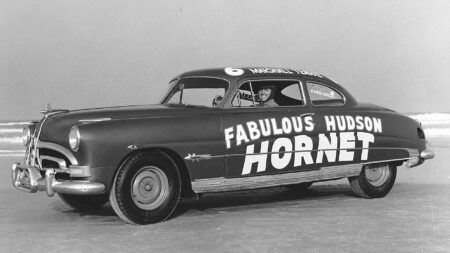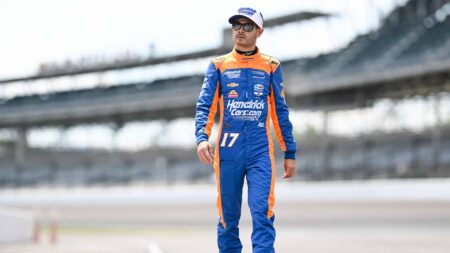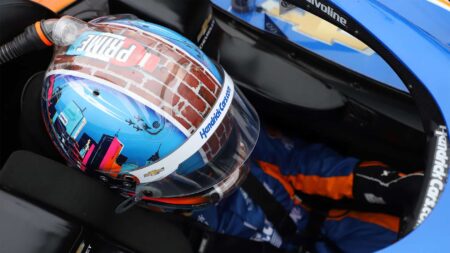
The real-life Hudson Hornet: story of a NASCAR icon
The massively successful Cars Disney film made Doc Hudson popular with fans young and old – James Elson tells the story behind the Hudson Hornet NASCAR it was based on
It’s become part of NASCAR legend that the fist fight between Cale Yarborough and the Allison brothers, Donnie and Bobby, after Cale and Donnie tangled in Turn 3 on the last lap while battling for the lead of the 1979 Daytona 500, helped propel NASCAR to major league status in American sport.
That year’s 500 was the first NASCAR race broadcast live from start to finish and a huge east coast blizzard contributed to a big snowbound TV audience for CBS. The Yarborough vs Allison fist fight became an instant video classic creating acres of front page coverage in the nation’s newspapers the next day.

Suddenly, 30 years after its creation, NASCAR had made the leap from being a regional southern sport to a growing national phenomenon. From there NASCAR went on to outstrip and then blow off Indycar racing as a TV commodity and establish itself as the brand name for automobile racing in America today.
But there was much more to NASCAR’s growth than the fist fight at Daytona in 1979. Bill France Sr and his oldest son Bill Jr were motor racing’s original dictators, ahead of Bernie Ecclestone, and they built NASCAR by their force of will. Bill Sr promoted the early races on Daytona Beach and built the high-banked 2.5-mile Daytona Speedway in 1957 and ’58. The track opened in ‘59 and the first 500 featured a thrilling side by side battle to the finish with three-time champion Lee Petty nosing out Johnny Beauchamp.
Through the ‘60s a series of new southern superspeedways opened in places like Charlotte, Atlanta and Talladega in Alabama. These tracks helped stock car racing grow and NASCAR began to boom after Bill Sr and his equally sharp and powerful son Bill Jr sold Winston cigarettes on sponsoring their series. The ’79 Daytona 500 helped but Winston was a big part of it. Another factor was an established, reliable calendar of 30 Winston Cup races that remained unchanged for almost 30 years.

Bill Elliott and Dale Earnhardt, Charlotte ’87
And of course, there was also a core group of great drivers – in particular Richard Petty, David Pearson, Bobby Allison and Cale Yarborough – who made their names in the ‘60s and enjoyed long and very successful careers through the ‘70s and ‘80s. Richard Petty, Lee’s son, won seven championships and 200 races on the way to becoming ‘The King‘ because of his gracious, charming manner as well as his remarkable performances on the track.
Known as ‘The Silver Fox’, David Pearson is NASCAR’s second most successful driver with 105 wins and 113 poles. Pearson won the championship in ‘66, ’68 and ’69 before running only a partial schedule with the Wood Brothers from 1972-79. Pearson used to carry a packet of cigarettes in his driver’s suit and when a yellow came out he would enjoy a smoke, but he was a silky smooth driver who was as good a road racer as any I’ve seen.
Bobby Allison was the leader of the ‘Alabama Gang’ which included his brother Donnie and Neil Bonnett, NASCAR race winners all. Bobby was the most successful, winning 84 Cup races and the 1983 championship. Bobby was as tough as they come but suffered through plenty of tragedy. Both his sons Davey and Clifford were killed, Davey aboard a helicopter and Clifford in a stock car, and Bobby’s career came to end with a huge crash at Pocono in 1988.
Then there was Cale Yarborough, a bulldog of a man from South Carolina. Yarborough was a boxer and semi-pro football player before focusing on his racing career. He made his first start in the Southern 500 at nearby Darlington in 1957 when he was only 18 and went on to win the Daytona 500 four times in 1968, ’77, ’83 and ’84 and the Southern 500 five times. Yarborough won the Winston Cup championship three years in a row in 1976-78 driving for former racer and whisky runner Junior Johnson, and won 83 NASCAR races before retiring at the end of 1988.

When it came to banging fenders and leaning on his competitors on the final lap Cale was right there with the Allison brothers and their intensity has gone down in history in the YouTube video of their fight at Daytona in ’79. But it’s wrong to think of them as fighters rather than racers. Yarborough and the Allisons were exciting drivers to watch and I enjoy fond memories of Cale and Bobby qualifying at Daytona in the days before restrictor plates.
In those days it used to be a pleasure to go down to the end of the backstretch to watch qualifying. With plenty of horsepower the cars took a lot of driving and Yarborough and Allison were great to watch as they flew into the Turn 3 banking, cracking the throttle and whirling the steering wheel as they threw their 4000lb beasts from the bottom to the top of the banking. Petty took a different approach, rim-riding at the top of banking as close to the fence as possible, while Pearson was fluid and precise like you might imagine Jim Clark would be at the wheel of a stock car.
It’s ironic of course that a pair of big accidents endured by Yarborough and Allison in 1987 ushered in the modern restrictor plate era at Daytona and Talladega. Yarborough flipped his car while qualifying at Daytona and Allison’s car flew over the fence and into the crowd at Talladega. The following year NASCAR introduced restrictor plates for the four races at their fastest tracks, cutting power almost in half.

The Alabama Gang
As a result these days it’s pedal to the metal all the way around Daytona and Talladega. Qualifying is like watching paint dry as everyone hugs the yellow line at the bottom of the track searching for the shortest, cleanest possible lap. And restrictor plate races are nothing more than crapshoots with crashes galore and many drivers choosing to hang around at the back of the pack hoping to first avoid the inevitable shunts and secondly for some late-race yellows to help get to the front for the final shootout.
The late Dale Earnhardt hated restrictor plate racing as do today’s superstars Jeff Gordon, Jimmie Johnson and Tony Stewart. But they begrudgingly accept it as part of the game now deeply ingrained in NASCAR’s soul.
Practice and qualifying starts at Daytona this weekend with two 150-mile qualifying races next Thursday evening and the 57th running of the 500 over 200 laps on Sunday afternoon, February 22. It’s impossible to predict who’ll be on the pole or who will win the race. It’s all about putting on a show for the fans and TV audience as row on row of cars jostle for position and everyone waits for ‘The Big One’ to happen. If a fight breaks out, it’ll be some welcome hot sauce for your pulled pork sandwich.

The massively successful Cars Disney film made Doc Hudson popular with fans young and old – James Elson tells the story behind the Hudson Hornet NASCAR it was based on

NASCAR star Kyle Larson is attempting 'The Double' this Sunday, driving the Indianapolis 500 and Coca-Cola 600 on the same day – but several factors could stand in his way

'The Double' is a challenge like no other in motor sport – we look at the brave racers who've taken on the Indianapolis 500 and Coca-Cola 600 on the same day

NASCAR has aimed big with its new Drive to Survive Netflix imitator Full Speed: can the docudrama match its lofty ambitions?